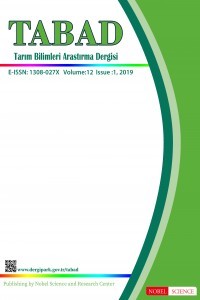Greenhouse production system choices: Is modern technology better for environment? Case study from Turkey
Tomato is one of the most widely cultivated crops in the world. Turkey produces on average almost 10 million tons of tomatoes annually. Greenhouse tomato production in Turkey has been significantly increasing in the last decade. However, environmental concerns are increasing especially about greenhouse production. There is also a misunderstanding among people that if a greenhouse is equipped with sophisticated technological systems of production, this will lead an environmentally friendly production because of more awareness, more certification, etc. However, studies show that there is not a significant correlation between technological investments and environmentally friendly practices. The empirical data used in this article was gathered by a research project which was granted by TUBITAK (Science and Technological Research Council of Turkey). A survey and observation techniques were used as a data collection method. Meanwhile, “Life Cycle Assessment” method was used to measure the impact of conventional farming and modern farming on the environment. The significant finding of the research is that even though profit obtained from unit area in a greenhouse which is equipped with a sophisticated technology is higher than a low technology greenhouse, there is a significant difference between high and low tech greenhouse systems in terms of environmental pollution
Anahtar Kelimeler:
Agriculture and ecology, life cycle assessment, technology, modern and conventional production
___
- Referans 1 [1] Mencet, M.N., Sayin, C. 2010. “Life Cycle Assessment Analysis of Greenhouse Tomato Production in Turkey”. LCA FOOD 2010 International Conference on Life Cycle Assessment in the Agri Food Sector, Volume 1, Bari-Italy 22-24 September (2010).Referans 2 [2]Loizou, E., Mattas, K., Tzouvelakas, V., Fotopoulos, C. Galanopoulos, K. 2000. Regional Economic Development and Environmental Repercussions: An Environmental Input-Output Approach, International Advances in Economic Research, Vol. (6), (3), (2000) (373-386). Referans [3] Guler, S. 2004. Fertilizer Consumption in Turkey and The World. 3. National Fertilizer Congress on Agriculture-Industry-Environment, 11-13 Oct. 2004, Tokat, page 47-54. (in Turkish) Referans 4 Yamane, T. 2001. Basic Sampling Methods, Literature Publishing. Turkish Edition (2001).Referans [5] Sayin, C., Karaman, S., Mencet, M.N. 2013. Ecological, Economical and Political analysis of Greenhouse Tomato Production in Antalya, Project Number: 109O159 TUBITAK (2013) (in Turkish)Referans [6]Rebitzer, G. VD. 2005. Life Cycle Assessment Part1: Framework, goal and scope definition, inventory analysis, and applications, J. Environmental International 30 (2004) 701-720.Referans [7] Anton, A., Montero, J.I., Munoz, P. 2005. “LCA and Tomato Production in Mediterranean Greenhouses”, International Journal of Agricultural Resources, Governance and Ecology 2005 - Vol. 4, No.2 pp. 102. Referans [8]Suh, S: Methods for Life Cycle Inventory of a product, Journal of Cleaner Production 13 (2005) 687-697.Referans [9] Burkett, P. 2004. Marx and Nature, Epos Publication, Turkish Edition, pg 30-34.[10] Foster, J. B. 2004. The Vulnerable Planet: A Short Economic History of the Environment, New York: Monthly Review Press. Turkish Edition pg. 20-25.
- Başlangıç: 2008
- Yayıncı: Nobel Bilim ve Araştırma Merkezi Limited
Sayıdaki Diğer Makaleler
Düzce İlinde Ricania japonica Melichar (Hemiptera: Ricaniidae)’nın Konukçu Bitkilerinin Belirlenmesi
Nida KÜLCÜOĞLU, Şükran YAYLA, Sevcan ÖZTEMİZ
Hilmi TORUN, Feyzullah Nezihi UYGUR
Şile (İstanbul) Su Ürünleri Kooperatifi ve Ortaklarının Sosyo - Ekonomik Analizi
Kadir DOĞAN, Zahit Tuğrul ALIÇLI
Üzüm ve Fermente Üzüm Sularında Bulunan Resveratrol Miktarını Etkileyen Faktörler
Acı Kavun (Ecballium elaterium (L.) A. Rich.) Bitkisinde Kallus Kültürü Araştırmaları
Sevil SAĞLAM YILMAZ, Elif AKYILDIZ
Göller Bölgesi Tahıl Üretim Alanlarında Yaprakbiti Türlerinin Belirlenmesi
